Related Research Articles
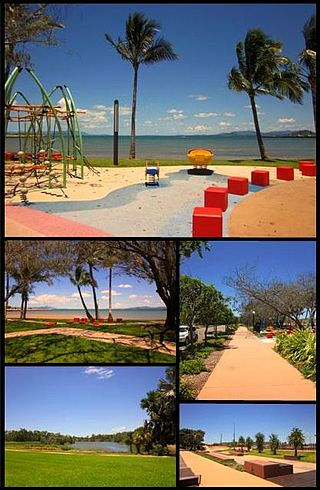
Bowen is a coastal town and locality in the Whitsunday Region, Queensland, Australia. In the 2021 census, the locality of Bowen had a population of 11,205 people.
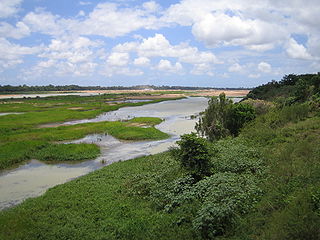
The Burdekin River is a river in North and Far North Queensland, Australia. The river rises on the northern slopes of Boulder Mountain at Valley of Lagoons, part of the western slope of the Seaview Range, and flows into the Coral Sea at Upstart Bay over 200 kilometres (124 mi) to the southeast of the source, with a catchment area of approximately 130,000 square kilometres (50,000 sq mi). The Burdekin River is Australia's largest river by (peak) discharge volume.

Ayr is a rural town and locality in the Shire of Burdekin, Queensland, Australia. It is the centre of a sugarcane-growing region and the administrative centre for the Burdekin Shire Council. In the 2021 census, the locality of Ayr had a population of 8,603 people.
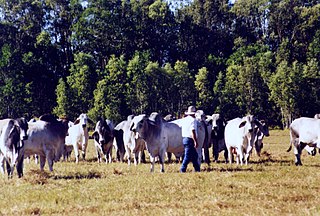
In Australia, a stockman is a person who looks after the livestock on a station, traditionally on horse. It has a similar meaning to "cowboy". A stockman may also be employed at an abattoir, feedlot, on a livestock export ship, or with a stock and station agency.

In Australia and New Zealand, a cattle station is a large farm, the main activity of which is the rearing of cattle. The owner of a cattle station is called a grazier. The largest cattle station in the world is Anna Creek Station in South Australia, which covers an area of 23,677 square kilometres.

A drover in Australia is a person, typically an experienced stockman, who moves livestock, usually sheep, cattle, and horses "on the hoof" over long distances. Reasons for droving may include: delivering animals to a new owner's property, taking animals to market, or moving animals during a drought in search of better feed and/or water or in search of a yard to work on the livestock. The drovers who covered very long distances to open up new country were known as "overlanders".

Collinsville is a rural town and locality in the Whitsunday Region, Queensland, Australia. In the 2021 census, the locality of Collinsville had a population of 1,496 people.

The Isaac Region is a local government area located in Central Queensland, Queensland, Australia created in March 2008 as a result of the report of the Local Government Reform Commission released in July 2007.
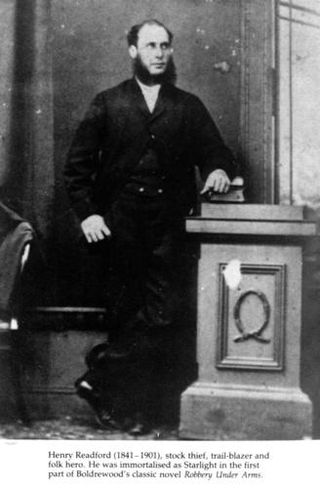
Henry Arthur Readford, was an Australian stockman, drover and cattle thief.
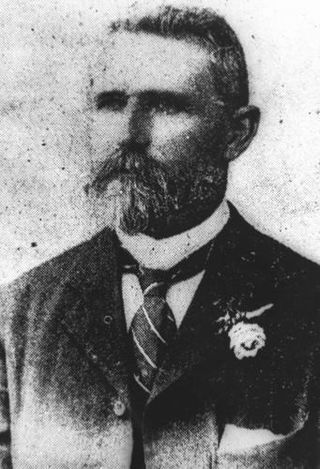
William Aplin was an Australian pioneer, businessman and politician of Queensland, Australia in the 19th century.

The Belyando River, including the Belyando River (Western Branch), is a river system in Central Queensland, Australia. At 1,054 kilometres (655 mi) in length and with a catchment area of 35,000 square kilometres (14,000 sq mi), the Belyando River system is one of the longest rivers in Queensland.
The Suttor River is a river in Central Queensland, Australia. The Belyando River is its main tributary. The river has its origins in the Leichhardt Range, north west of Glenden. It flows into Lake Dalrymple, becoming a tributary of the Burdekin River.
Iffley Station is a pastoral lease that currently operates as a cattle station in Queensland.

John Graham MacDonald (1834–1918) was an explorer and pioneer in Queensland, Australia.

Bowen Developmental Road is a state-controlled district road rated as a local road of regional significance (LRRS). It is a rural strategic main road in Queensland, Australia. It is part of State Route 77, and functions as a highway. It has a length of 259 kilometres (161 mi) and extends in northeast-southwest direction from Bowen on the east coast of Australia to the Gregory Developmental Road in Belyando near Nairana National Park.
Belyando is a rural locality in the Isaac Region, Queensland, Australia. In the 2021 census, Belyando had a population of 307 people.
The Yangga, also spelt Jangga, are an Aboriginal Australian people of the state of Queensland. They are not to be confused with the Yanga people.
Keeroongooloo, previously known as Keerongooloo or Keerongoola is a pastoral lease that operates as a cattle station in the Channel Country of South West Queensland, Australia.

James Earl (1835–1907) was a merchant in Far North Queensland of cartage and started cattle breeding.

Alligator Creek Meatworks is an important historical business in Queensland contributing to processing of food for the growing population and processing meet while the meat and cattle industry expanded the economy of the local area and of Australia with the introduction of meat exportation. Early meatworks included boiling down and preserving. Later meatworks used freezer technology and equipment. The meatworks is no longer in operation, but the photos and historical accounts provide an insight into rural life in early Australia and Queensland.
References
- 1 2 3 4 5 6 7 8 9 10 11 12 13 14 15 16 17 18 19 "YACAMUNDA STATION". Central Queensland Herald. 1935-08-01. Retrieved 2024-06-15.
- ↑ "Butcher's Hill farm to Yacamunda and Butcher's Hill Station : a chronological record of the early... - Catalogue | National Library of Australia". catalogue.nla.gov.au. Retrieved 2024-06-15.
- ↑ "Homestead at Yacamunda Station near Bowen. | State Library of Queensland". www.slq.qld.gov.au. Retrieved 2024-06-15.
- 1 2 3 "ON THE TOP RAIL". Townsville Daily Bulletin. 1946-06-04. Retrieved 2024-07-11.
- ↑ Thomas, Nick (Dec 8, 2022). Yaca-Munda: Aboriginal for Work for your Tucker. Nick Thomas. ISBN 9781471028533.
- 1 2 3 Hatte, E., Cook P., Northern Archaeology Consultancies. (2012, March). Non indigenous Historical Technical Report , p.14. https://eisdocs.dsdip.qld.gov.au/Byerwen%20Coal/EIS/Appendices/appendix-27-non-indigenous-history-technical-report.pdf
- 1 2 3 "Townsville "Bulletins."". Evening Telegraph. 1905-10-16. Retrieved 2024-06-15.
- ↑ "Qld station brings $38m". Australian Financial Review. 2007-02-13. Retrieved 2024-06-15.